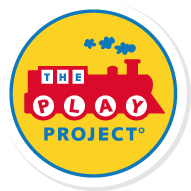Research & Evidence
PLAY Project Research
A ‘Parent Implemented Model’ of Autism Early Intervention
The P.L.A.Y. Project® started as a small experimental program at the University of Michigan and has now become a nationally and internationally recognized model of autism early intervention.
Research on The PLAY Project joins a growing number of high quality studies that show that parents can be coached to effectively engage their child who has an autism spectrum disorder.
The research literature is clear: When parents successfully engage their child, the child makes progress in his/her social interaction and development, and autism symptoms improve.
In 2009, The PLAY Project Organization was awarded a $1.85 million grant through the National Institute of Health (NIH) the prestigious national grant funding agency.
In this rigorously designed study, children were randomly assigned to either a community intervention only group, where they received pre-school services for 12 hours per week, or a community intervention plus PLAY Project group. Five Easter Seals (a nonprofit service organization) sites in 4 states recruited 64 children per year in two groups (i.e. 64 children one year and 64 children the next year) and provided PLAY intervention services.
PLAY Consultants made monthly home visits, coached parents to engage their children using PLAY principles, methods, techniques, and activities, and provided monthly video and written feedback.
Michigan State University conducted the independent evaluation. Altogether, 128 children were recruited for the study making it the largest study on autism intervention in the U.S. The study has been published in the peer reviewed Journal of Developmental and Behavioral Pediatrics.
Solomon R, Van Egeren L, Mahoney G, Quon-Huber M, Zimmerman P. PLAY Project Home Consultation Intervention Program for Young Children with autism spectrum disorders: A Randomized Controlled Trial. J Dev Beh Pediatr. 2014; 35(8): 475-485.
The PLAY Project has been officially adopted by Ohio’s early intervention system. All children 18 months to 3 years old who have been diagnosed with an ASD or have traits of autism get PLAY Project services free. To read about The PLAY Project’s statewide dissemination in Ohio’s early intervention system, click here!
Click here to view a list of articles that show evidence for PLAY.
Click here to view a list of review articles that include evidence for parent implemented, developmental relationship-based models for autism early intervention.
Key Study Findings
Finding #1
PLAY Project Consultants at each of the Easter Seals sites showed high fidelity to the model (i.e. they delivered services as described in the fidelity manual).
Finding #2
PLAY parents were more sensitive (able to ‘read’ their child’s cues), more responsive (able to follow child’s intentions), and more effective (able to get more back and forth interactions with their child).
Finding #3
PLAY Parents showed a significant reduction in depression compared to control parents.
Finding #4
PLAY Children markedly improved their ability to interact (e.g. initiated to parents a lot more), and be social, and substantially reduced their autism symptoms.

Too many young children with autism are waiting for services.
The PLAY Project’s Autism Early Intervention Program is an effective parent training program that can be broadly and quickly disseminated to serve the growing number of young children with ASD.
To read about the PLAY Project’s statewide dissemination in Ohio’s Early Intervention system, click here.
Parent implemented models are recognized by the National Professional Development Center as evidence-based intervention. The PLAY Project has an entry in the prestigious Encyclopedia of Autism Spectrum Disorders edited by Fred Volkmer M.D.
Richard Solomon, MD, founder of The PLAY Project, describes research and evidence for parent-implemented models. Read Richard Solomon, MD’s commentary article on this topic here.
PIM DRB Reviews:
Binns, Oram-Cardy (2019) Developmental social pragmatic interventions for preschoolers with autism spectrum spectrum disorder: A systematic review. Autism & Developmental Language Impairments. 4(1): 1-18 DOI: 10.1177/2396941518824497
Sandbank, M., Bottema-Beutel, K., Crowley, S., Cassidy, M., Dunham, K., Feldman, J. I., Crank, J., Albarran, S. A., Raj, S., Mahbub, P., & Woynaroski, T. G. (2019, November 25). Project AIM: Autism intervention meta-analysis for studies 517 of young children. Psychological Bulletin. Advance online publication. https://doi.org/10.1037/bul0000215.
Smith T, & Iadarola S. (2015) Evidence-based update for Autism Spectrum Disorders. Journal of Clinical Child & Adolescent Psychology, 44(6), 897-922.
Solomon (2018). Commentary: Evidence based interventions for children and adolescents with Autism Spectrum Disorders in Current Problems in Pediatric and Adolescent Medicine 2018; 48: 267-269 https://doi.org/10.1016/j.cppeds.2018.08.017
Wong, C., Odom, et.al. Evidence-based practices for children, youth, and young adults with Autism Spectrum Disorder (2014). Chapel Hill: The University of North Carolina, Frank Porter Graham Child Development Institute, Autism Evidence-Based Practice Review Group. This report is available at: http://autismpdc.fpg.unc.edu/sites/autismpdc.fpg.unc.edu/files/2014-EBP-Report.pdf
Mercer J. (2015) Examining DIR/Floortime as a Treatment for Children with Autism Spectrum Disorders: A Review of Research and Theory. Research on Social Work Practice. May, 1-11.
Mandell D, Barry C, et al. (2016). Effects of Autism Spectrum Disorder Insurance Mandates on the Treated Prevalence of Autism Spectrum Disorder MPP; JAMA Pediatr. doi:10.1001/jamapediatrics 1049. Published online July 11, 2016.
TRICARE-Autism-Report Concerns About Effectiveness.
